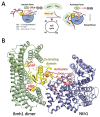Look for the Scaffold: Multifaceted Regulation of Enzyme Activity by 14-3-3 Proteins
- PMID: 38647170
- PMCID: PMC11412345
- DOI: 10.33549/physiolres.935306
Look for the Scaffold: Multifaceted Regulation of Enzyme Activity by 14-3-3 Proteins
Abstract
Enzyme activity is regulated by several mechanisms, including phosphorylation. Phosphorylation is a key signal transduction process in all eukaryotic cells and is thus crucial for virtually all cellular processes. In addition to its direct effect on protein structure, phosphorylation also affects protein-protein interactions, such as binding to scaffolding 14-3-3 proteins, which selectively recognize phosphorylated motifs. These interactions then modulate the catalytic activity, cellular localisation and interactions of phosphorylated enzymes through different mechanisms. The aim of this mini-review is to highlight several examples of 14-3-3 protein-dependent mechanisms of enzyme regulation previously studied in our laboratory over the past decade. More specifically, we address here the regulation of the human enzymes ubiquitin ligase Nedd4-2, procaspase-2, calcium-calmodulin dependent kinases CaMKK1/2, and death-associated protein kinase 2 (DAPK2) and yeast neutral trehalase Nth1.
Conflict of interest statement
Figures


Similar articles
-
Structural basis of the 14-3-3 protein-dependent activation of yeast neutral trehalase Nth1.Biochim Biophys Acta. 2013 Oct;1830(10):4491-9. doi: 10.1016/j.bbagen.2013.05.025. Epub 2013 May 29. Biochim Biophys Acta. 2013. PMID: 23726992
-
Molecular basis of the 14-3-3 protein-dependent activation of yeast neutral trehalase Nth1.Proc Natl Acad Sci U S A. 2017 Nov 14;114(46):E9811-E9820. doi: 10.1073/pnas.1714491114. Epub 2017 Oct 30. Proc Natl Acad Sci U S A. 2017. PMID: 29087344 Free PMC article.
-
Role of individual phosphorylation sites for the 14-3-3-protein-dependent activation of yeast neutral trehalase Nth1.Biochem J. 2012 May 1;443(3):663-70. doi: 10.1042/BJ20111615. Biochem J. 2012. PMID: 22320399
-
Allosteric activation of yeast enzyme neutral trehalase by calcium and 14-3-3 protein.Physiol Res. 2019 Apr 30;68(2):147-160. doi: 10.33549/physiolres.933950. Epub 2019 Jan 10. Physiol Res. 2019. PMID: 30628830 Review.
-
Small proteins that modulate calmodulin-dependent signal transduction: effects of PEP-19, neuromodulin, and neurogranin on enzyme activation and cellular homeostasis.Mol Neurobiol. 2000 Aug-Dec;22(1-3):99-113. doi: 10.1385/MN:22:1-3:099. Mol Neurobiol. 2000. PMID: 11414283 Review.
References
Publication types
MeSH terms
Substances
LinkOut - more resources
Full Text Sources
Miscellaneous
